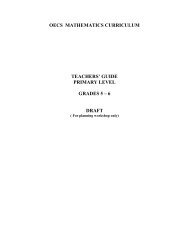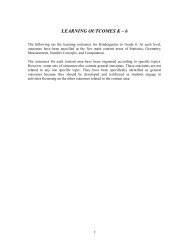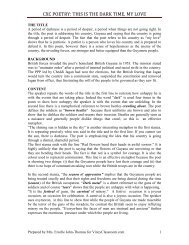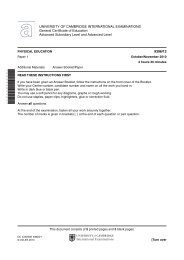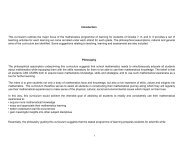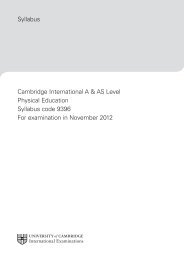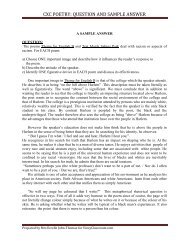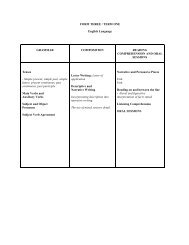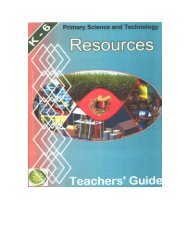Mathematics Programme of Learning - VincyClassroom
Mathematics Programme of Learning - VincyClassroom
Mathematics Programme of Learning - VincyClassroom
Create successful ePaper yourself
Turn your PDF publications into a flip-book with our unique Google optimized e-Paper software.
<strong>Mathematics</strong> – Curriculum Guide for Secondary Schools Grades 7 – 9 (Forms 1 -3)<br />
SUBJECT: MATHEMATICS STRAND: 1- NUMBER and NUMBER SENSE EDUCATION STAGE: 3<br />
ATTAINMENMT TARGET: Students develop competency, confidence, knowledge, skills and understanding in mental and written computations<br />
as well as effective calculator use and numerical reasoning when working with numbers<br />
LEARNING<br />
OUTCOMES<br />
ACHIEVEMENT INDICATORS<br />
Grade 7<br />
NUMBER and NUMBER SENSE – Whole number Computations<br />
LO: 03<br />
7.3.1 Use, read, write and spell<br />
Understand, select<br />
vocabulary related to the four<br />
and apply<br />
basic operations: sum, total,<br />
appropriate<br />
difference, product, quotient,<br />
strategies for the four divisor, dividend, subtract,<br />
basic operations; and minus, combine, multiple<br />
develop ways to<br />
check accuracy <strong>of</strong><br />
computations<br />
7.3.2 Calculate the value <strong>of</strong> whole<br />
number statements containing<br />
up to three operations using the<br />
order <strong>of</strong> arithmetic operations<br />
(BODMAS)<br />
ACHIEVEMENT INDICATORS<br />
Grade 8<br />
8.3.1 Use, read, write and spell<br />
vocabulary related to the four<br />
basic operations: sum, total,<br />
difference, product, quotient,<br />
divisor, dividend, subtract,<br />
minus, combine, multiple<br />
8.3.2 Calculate the value <strong>of</strong> whole<br />
number statements containing up<br />
to four operations using the order<br />
<strong>of</strong> arithmetic operations<br />
(BODMAS)<br />
ACHIEVEMENT INDICATORS<br />
Grade 9<br />
9.3.1 Use, read, write, and spell<br />
vocabulary related to the four<br />
basic operations: sum, total,<br />
difference, product, quotient,<br />
divisor, dividend, subtract,<br />
minus, combine, multiple<br />
9.3.2 Calculate the value <strong>of</strong> whole<br />
number statements containing<br />
up to four operations using<br />
the order <strong>of</strong> arithmetic<br />
operations (BODMAS)<br />
7.3.3 Know the multiplication tables<br />
up to 10 × 10<br />
7.3.4 Identify emerging patterns when<br />
multiplying whole numbers by<br />
10 and multiples <strong>of</strong> 10, and 100<br />
and multiples <strong>of</strong> 100<br />
7.3.5 Apply different strategies to<br />
perform multiplication by two<br />
or more digits<br />
7.3.6 Apply different strategies to<br />
perform division by up to two<br />
digit<br />
8.3.3 Demonstrate different ways <strong>of</strong><br />
performing multiplication <strong>of</strong> a<br />
whole numbers involving a<br />
multiplier consisting <strong>of</strong> two or<br />
more digits<br />
8.3.4 Use examples to demonstrate that<br />
multiplication is the inverse <strong>of</strong><br />
division<br />
8.3.5 Use appropriately the principles<br />
<strong>of</strong> commutative, associative and<br />
distributive laws as applied to<br />
multiplications<br />
8.3.6 Check multiplication by dividing<br />
9.3.3 Use examples to illustrate<br />
different rules relating to the<br />
order <strong>of</strong> operation<br />
(BODMAS)<br />
9.3.4 Understand that<br />
multiplication is the inverse<br />
<strong>of</strong> division<br />
9.3.5 Use simple pro<strong>of</strong>s to illustrate<br />
the principles <strong>of</strong><br />
commutative, associative and<br />
distributive laws as applied to<br />
multiplications<br />
9.3.6 Develop approaches to<br />
7



